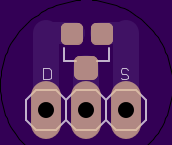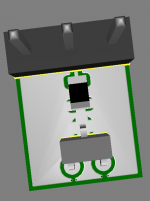thats for the jfet input stage for the amplifier where the quiescent is 2ma and 2Vds.😉you state 2V, 2ma & 2mW, yet the quote states 12Vds, ~20mA & 240mW ?
You're not doing too well.
> Since the BF862 is good for only 20-25V, it would be logical to cascode it anyway.
The 2SJ74 is also 25V, which will be sufficient for a large proportion of applications.
If you really want to go higher, then 2SK209 will be a good cascode.
But now you double your matching problem.
Technically all solvable, of course.
Patrick
The 2SJ74 is also 25V, which will be sufficient for a large proportion of applications.
If you really want to go higher, then 2SK209 will be a good cascode.
But now you double your matching problem.
Technically all solvable, of course.
Patrick
I was taught that 2 times 2 equals 4.thats for the jfet input stage for the amplifier where the quiescent is 2ma and 2Vds.😉
That tells me that 2V times 2mA equals 4mW
Which designer runs their jFETs at 2V?
Is that 2Vds, or 2Cgs, or 2Vdg?
> If you use an SMT adapter the leads will bleed off some heat.
To where, the FR4 PCB material (poor thermal conductor) ?
For audio applications, one wishes to place a gate stopper close to the gate pin.
So the copper on which the gate pin is soldered cannot have a large are for dissipation.
Patrick
Just an idea, you can also pour copper on the bottom and punch through vias.
Attachments
for 1:1 replacement G should be between D and S?
Indeed. Sorry, I missed the point. It is more how to use BF862 with thru hole pcb, than 2SK 170 replacement.
Sorry to Juma too. His pre/amps are designed to use BF862, not to replace 2SK170.
I remember reading much about the BF862, both from Juma's preamp thread, and some other stuff from John Curl and Scott Wurcer.
Cascoding is probably the way to go with them.
Have a look here
http://www.diyaudio.com/forums/loun...rch-preamplifier-part-ii-639.html#post2345688
Cascoding is probably the way to go with them.
Have a look here
http://www.diyaudio.com/forums/loun...rch-preamplifier-part-ii-639.html#post2345688
I was taught that 2 times 2 equals 4.
That tells me that 2V times 2mA equals 4mW
Which designer runs their jFETs at 2V?
Is that 2Vds, or 2Cgs, or 2Vdg?
Vds 2V
kypton V2 by ostipper..
This what I used

I had it for a few hours in a 10V DCB1 test circuit, and I do not remember it running hot.
I had it for a few hours in a 10V DCB1 test circuit, and I do not remember it running hot.
Attachments
Last edited:
> Cascoding is probably the way to go with them.
http://www.diyaudio.com/forums/digi...ng-new-ess-vout-dac-es9022-7.html#post2867664
Patrick
http://www.diyaudio.com/forums/digi...ng-new-ess-vout-dac-es9022-7.html#post2867664
Patrick
. . . Which designer runs their jFETs at 2V?
Is that 2Vds, or 2Cgs, or 2Vdg?
Depending on what you choose for the cascode device, the SWOPA discrete opamp will have Vds in the 2V - 4V range. See
http://www.diyaudio.com/forums/anal...screte-opamp-open-design-157.html#post3193208
et seq for circuits and discussions.
Dale
but there should be a reason why BF862 sounds better when 2sk170 is replaced?
I have a strong feeling that the input capacitance of BF862 is quite low as low as 3 times that of the 2sk170. Transconductance is double but will that really help?
Noise is also little bit better.
How far does the input capacitance makes difference?
I have a strong feeling that the input capacitance of BF862 is quite low as low as 3 times that of the 2sk170. Transconductance is double but will that really help?
Noise is also little bit better.
How far does the input capacitance makes difference?
I fear you might be barking up the wrong tree if you're trying to discern some sort of audibility test between these two JFETS: they're either appropriately designed into the circuit and do their job, or not.
The higher speed of the BF82 does come at some stability cost.
The higher speed of the BF82 does come at some stability cost.
- Status
- Not open for further replies.
- Home
- Amplifiers
- Pass Labs
- BF862 instead of 2sk170?


